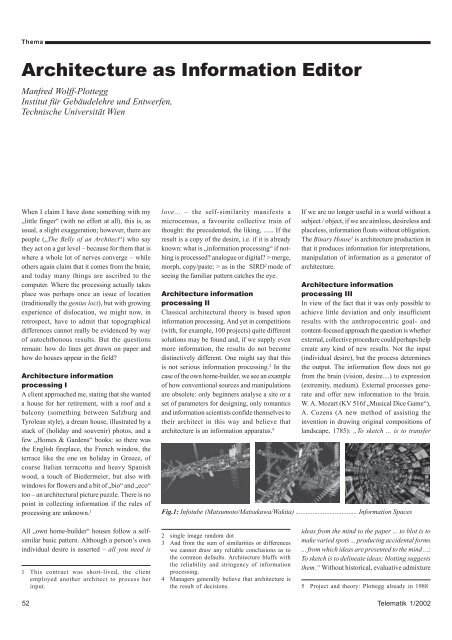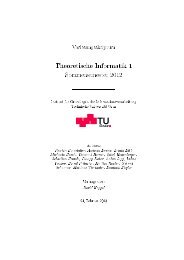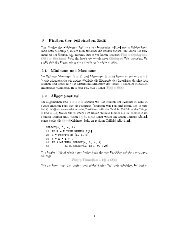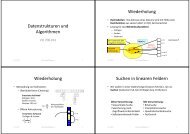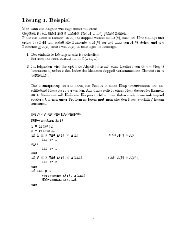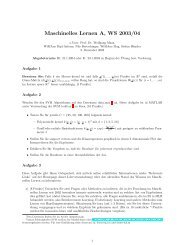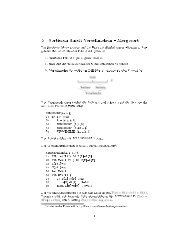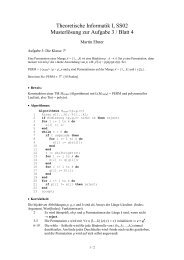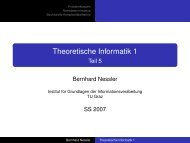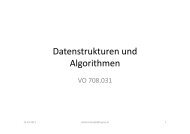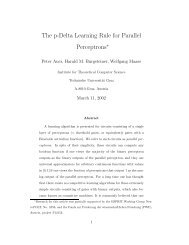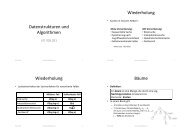Telematik 2/02 - Institut für Grundlagen der Informationsverarbeitung ...
Telematik 2/02 - Institut für Grundlagen der Informationsverarbeitung ...
Telematik 2/02 - Institut für Grundlagen der Informationsverarbeitung ...
You also want an ePaper? Increase the reach of your titles
YUMPU automatically turns print PDFs into web optimized ePapers that Google loves.
Thema<br />
Architecture as Information Editor<br />
Manfred Wolff-Plottegg<br />
<strong>Institut</strong> <strong>für</strong> Gebäudelehre und Entwerfen,<br />
Technische Universität Wien<br />
When I claim I have done something with my<br />
„little finger“ (with no effort at all), this is, as<br />
usual, a slight exaggeration; however, there are<br />
people („The Belly of an Architect“) who say<br />
they act on a gut level – because for them that is<br />
where a whole lot of nerves converge – while<br />
others again claim that it comes from the brain;<br />
and today many things are ascribed to the<br />
computer. Where the processing actually takes<br />
place was perhaps once an issue of location<br />
(traditionally the genius loci), but with growing<br />
experience of dislocation, we might now, in<br />
retrospect, have to admit that topographical<br />
differences cannot really be evidenced by way<br />
of autochthonous results. But the questions<br />
remain: how do lines get drawn on paper and<br />
how do houses appear in the field?<br />
Architecture information<br />
processing I<br />
A client approached me, stating that she wanted<br />
a house for her retirement, with a roof and a<br />
balcony (something between Salzburg and<br />
Tyrolean style), a dream house, illustrated by a<br />
stack of (holiday and souvenir) photos, and a<br />
few „Homes & Gardens“ books: so there was<br />
the English fireplace, the French window, the<br />
terrace like the one on holiday in Greece, of<br />
course Italian terracotta and heavy Spanish<br />
wood, a touch of Bie<strong>der</strong>meier, but also with<br />
windows for flowers and a bit of „bio“ and „eco“<br />
too – an architectural picture puzzle. There is no<br />
point in collecting information if the rules of<br />
processing are unknown. 1<br />
All „own home-buil<strong>der</strong>“ houses follow a selfsimilar<br />
basic pattern. Although a person’s own<br />
individual desire is asserted – all you need is<br />
1 This contract was short-lived, the client<br />
employed another architect to process her<br />
input.<br />
love... – the self-similarity manifests a<br />
microcensus, a favourite collective train of<br />
thought: the precedented, the liking, ...... If the<br />
result is a copy of the desire, i.e. if it is already<br />
known: what is „information processing“ if nothing<br />
is processed? analogue or digital? > merge,<br />
morph, copy/paste; > as in the SIRD 2 mode of<br />
seeing the familiar pattern catches the eye.<br />
Architecture information<br />
processing II<br />
Classical architectural theory is based upon<br />
information processing. And yet in competitions<br />
(with, for example, 100 projects) quite different<br />
solutions may be found and, if we supply even<br />
more information, the results do not become<br />
distinctively different. One might say that this<br />
is not serious information processing. 3 In the<br />
case of the own home-buil<strong>der</strong>, we see an example<br />
of how conventional sources and manipulations<br />
are obsolete: only beginners analyse a site or a<br />
set of parameters for designing, only romantics<br />
and information scientists confide themselves to<br />
their architect in this way and believe that<br />
architecture is an information apparatus. 4<br />
If we are no longer useful in a world without a<br />
subject / object, if we are aimless, desireless and<br />
placeless, information floats without obligation.<br />
The Binary House 5 is architecture production in<br />
that it produces information for interpretations,<br />
manipulation of information as a generator of<br />
architecture.<br />
Architecture information<br />
processing III<br />
In view of the fact that it was only possible to<br />
achieve little deviation and only insufficient<br />
results with the anthropocentric goal- and<br />
content-focused approach the question is whether<br />
external, collective procedure could perhaps help<br />
create any kind of new results. Not the input<br />
(individual desire), but the process determines<br />
the output. The information flow does not go<br />
from the brain (vision, desire....) to expression<br />
(extremity, medium). External processes generate<br />
and offer new information to the brain.<br />
W. A. Mozart (KV 516f „Musical Dice Game“),<br />
A. Cozens (A new method of assisting the<br />
invention in drawing original compositions of<br />
landscape, 1785): „To sketch ... is to transfer<br />
Fig.1: Infotube (Matsumoto/Matsukawa/Wakita) .................................... Information Spaces<br />
2<br />
3<br />
single image random dot<br />
And from the sum of similarities or differences<br />
we cannot draw any reliable conclusions as to<br />
ideas from the mind to the paper ... to blot is to<br />
make varied spots ... producing accidental forms<br />
... from which ideas are presented to the mind ...;<br />
the common defaults. Architecture bluffs with<br />
the reliability and stringency of information<br />
processing.<br />
To sketch is to delineate ideas; blotting suggests<br />
them.“ Without historical, evaluative admixture<br />
4 Managers generally believe that architecture is<br />
the result of decisions. 5 Project and theory: Plottegg already in 1988<br />
52 <strong>Telematik</strong> 1/20<strong>02</strong>


